Was Post Impressionism Well Accepted by the Art World
When it comes to Postal service Impressionism fine art, nosotros cannot phone call it a result of a proper artistic motion, although it is surely considered to exist one of the virtually important parts in the history of arts. Rather, it was an assembly of different styles, techniques and fifty-fifty approaches to painting, adopted by a new generation of artists working roughly between 1885 and 1910 - or between the terminal Impressionist exhibition and the birth of Fauvism. Although each of these creatives went their own way, and fifty-fifty hated and criticized each other, they were all jump by the same guiding idea - to reject the limitations of Impressionist fine art and to use only the basic visual concepts of their predecessors in lodge to take their artistry to the next level.
The term "post impressionism art", all the same, wasn't introduced until 1906, and then 1910, by English artist and critic Roger Fry, fifty-fifty though this form of painting was more than established by that time. As such, this period has even managed to course the strongest roots of modernistic art for the side by side eighty years.
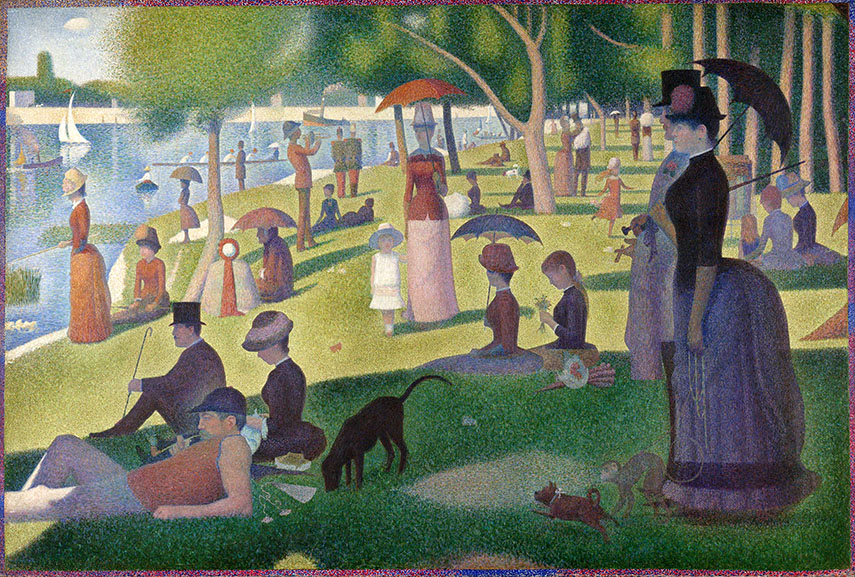
Impressionism vs Mail service Impressionism Art
The fact that new directions in art come to life as a response to some other management represents the very backbone of the creation of advanced movements of the late 19th and almost all of the 20th century; we tin can perhaps even say that information technology all started with the advent of Modernism and these two tendencies. If the painters of Impressionism such as Claude Monet, Eugéne Delacroix, Pierre-Auguste Renoir and J.Thousand.W. Turner strived to record nature in terms of the avoiding furnishings of light and colour, Post Impressionists like Georges Seurat, Paul Gauguin, Paul Cézanne, Henri de Toulouse-Lautrec and Vincent van Gogh wanted to extend these boundaries.
The Impressionists, indeed, mastered the approach of transmitting the way calorie-free dissolves into water surface to the utmost accuracy, but the Mail Impressionists felt this technique, ironically, overshadowed the subjects of many of these paintings, thus causing them to lose construction. In plough, their ain colors were still bold and intense, yet more than expressive and less idyllic, every bit their scenery broke abroad from the celebrated naturalism and focused on other themes like real-life and personal subject matter, which later on added more perspective and shapes to information technology all.
A Discussion on Post Impressionism
Post-Impressionist Examples and Styles
Post Impressionism art introduced a number of stylistic innovations that accept revolutionized the medium of painting itself and paved the way for many movements to come. The first to do so was Georges Seurat, who developed an entire science of colour. At present known as Pointillism, it is a style of painting in which the artist systematically painted small, distinct dots of pure color, thus extending the Impressionism's involvement in eyes. When seen from distant, these dots blend before the viewer creating a clearer, wider paradigm. Probably the nearly famous example of Georges Seurat's Pointillism technique is the 1884-86 A Sunday Afternoon on the Island of La Grande Jatte, which had also inspired fellow Mail service-Impressionist Paul Signac to dive into like explorations.
Paul Cézanne, previously a dedicated Impressionist, became known for being very "orderly". The coherence and permanence of his still lifes, landscapes and portraits were monumental and structured, reducing objects to their basic shapes while retaining the saturated colors of Impressionism. "Treat nature in terms of the cylinder, the sphere, the cone," Paul Cézanne in one case wrote, mayhap announcing himself as a bridge to Cubism and Abstruse art while painting a new kind of depth of field using geometric shapes. His masterpiece The Large Bathers is the carrier of such visual effect, in which the foreground merges with the background simultaneously and consecutively.
Terms like Cloisonnism, Synthetism and Symbolism, for instance, were all linked to the works of Paul Gauguin. In his 1889 The Yellow Christ, the artist intended to simplify the shapes and amplify the pure colors and strong lines, leading 2-dimensionality to evoke an emotional impact of a kind. Many of these artworks are labeled Cloisonnist, coined by the critic Edouard Dujardin and referring to the jewelry technique of inlaying metallic surfaces with "cloisonné" enamel colors. Many of Paul Gauguin's paintings depicted scenery and personalities from literature, faith and mythology.
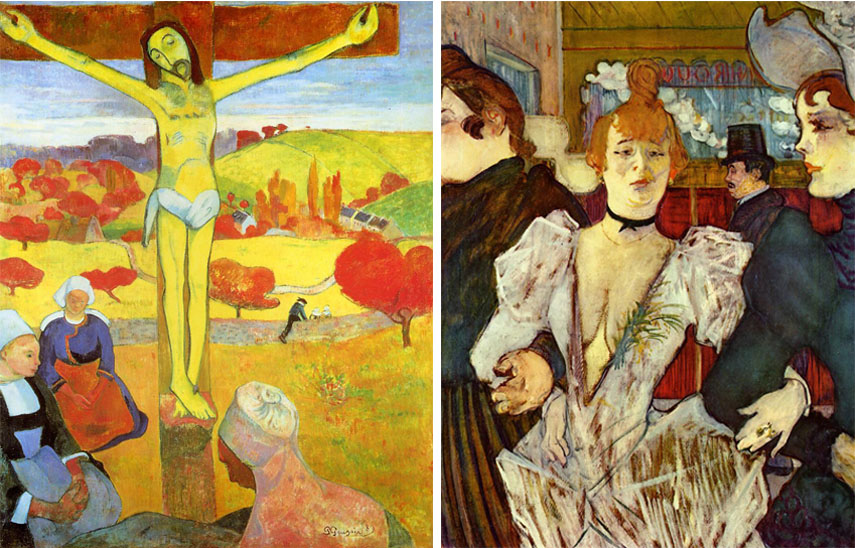
The Fine art of Vincent van Gogh
Mail service Impressionism art was also highly personal, mostly thanks to Vincent van Gogh and his powerful depictions of inner turmoil, driven by mental affliction. A crucial office of all history of art, the Dutch painter contributed to the period with his remarkable, broad, swirly brushstrokes and bright colors, which were sometimes inspired past the Japanese woodblock prints, also known as ukiyo-east. Not only did he give his all for his art, only van Gogh as well spent all his time doing it as well; even though he only painted for the concluding 10 years of his life, he painted most 900 paintings, which amounts to at to the lowest degree once every four days. No creative person has always managed to convey personal feelings of what he saw as potent and equally emotionally as him, despite the fact he idea very little of himself and never got to see the success he and his marvelous paintings were going to become.
Van Gogh'south oeuvre depicts his moods very accurately and passionately - from the illustrations of his darkest 60 minutes, similar in the 1885 Irish potato Eaters and the ominous blackbirds in the 1890 Wheatfield with Crows to the strongly optimistic Sunflowers series, followed past the gnarled twisted branches in The Olive Pickers from 1889. The great master inspired entire generations of artists to limited feelings through purposely distorted form and color, whatever their mood might exist. Permit us just think of the famous Starry Night, ane of the most recognizable paintings in the world and arguably the finest case of Post Impressionism's breakaway from Impressionism: it depicts quite an ordinary view in a quite extraordinary way, but what makes this artwork and then remarkable is the fact that it was the view from the painter'southward window of his aviary room at Saint-Rémy-de-Provence, to which he voluntarily checked in after the self-mutilation of his ear. Equally he did with many of his paintings, van Gogh referred to information technology as a "failure" and cared very little for it.
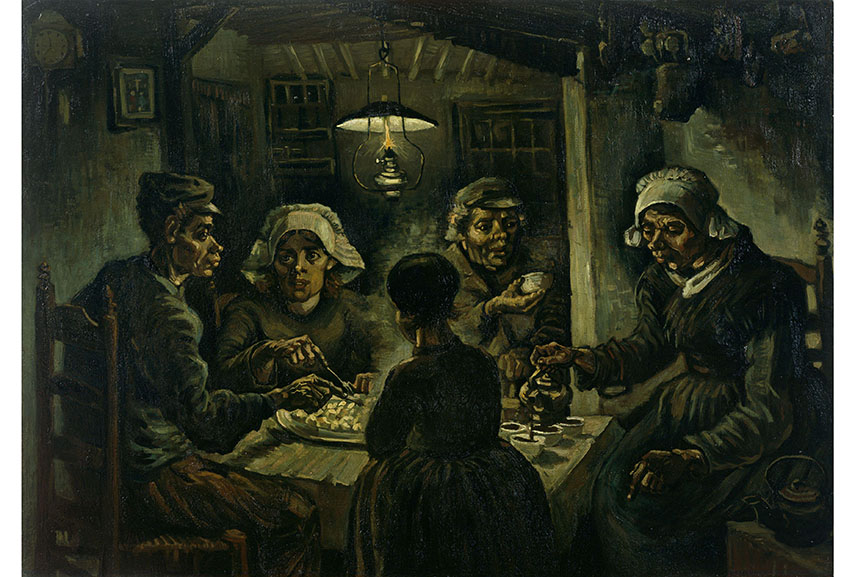
Post Impressionism on a Global Calibration - Central International Groups
Although Post Impressionism art was described past the aforementioned Roger Fry equally the evolution of French art since Monet at the 1910 exhibition he organized himself, the motion evolved beyond Paris besides. The French capital was indeed the true hub of many international artists who sought inspiration and fame of all kinds, only the ideas and styles kept evolving and actualization in other cities in France, besides as other countries in Europe, and the world. Recall about how a small, rural village of Worpswede near Bremen was colonized by a group of painters in the early on 1890s, including Paula Modersohn-Becker, Hans am Ende and Fritz Mackensen. These individuals introduced Post Impressionism art to Frg, and although it was not as influential equally in France, its approach was widely accustomed in the absence of a strong tradition of Impressionism.
Going back to the French soil, Post Impressionism had a stiff influence on other creative fields, like Poster art and Graphic design. Poster art, as the ultimate form of decorative art, flourished with the development of printing processes and walked mitt-in-hand with another of import movement, Art Nouveau, donning the artwork by Henri de Toulouse-Lautrec and Alphonse Mucha. In Paris, there was besides a famous group of Mail service-Impressionist artists and illustrators called Les Nabis, which was very impactful in the expanse of graphic art. Here, we have noted painters and designers similar Pierre Bonnard, Paul Serusier and Edouard Vuillard, the latter being perhaps the most famous among them. Vuillard was known for his intimist styles of flickering color as seen in Adult female Sewing Earlier a Garden (1895) or 1894-95 In The Garden.
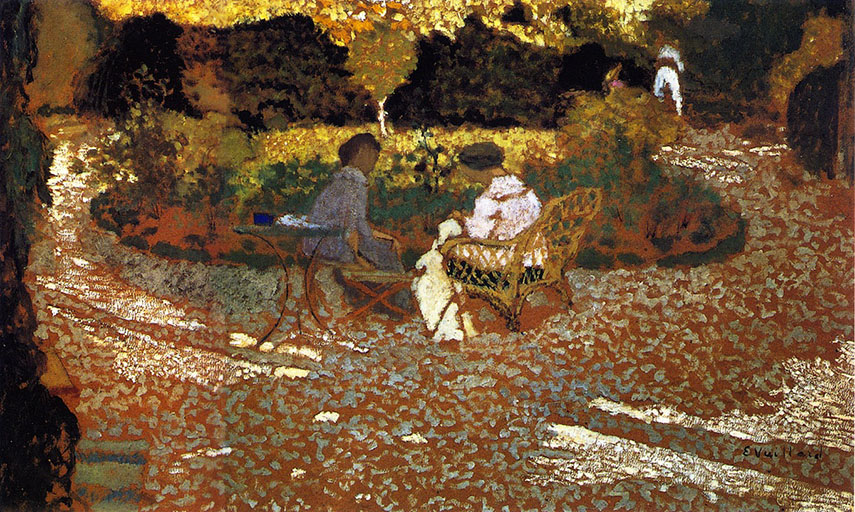
In Scandinavia
Surely when we recollect about Post Impressionism in Scandinavia, we think of Edvard Munch and his 1895 The Scream, which at present stands among the nearly expensive and the nigh famous paintings in the earth. His originality is widely recognized as i of the main sources of the movement in general. In his homeland of Norway, some other highly respectable painter was Peder Severin Kroyer, who was associated with a group of more realistic "painters of light" known as the Skagen colony. In Denmark, Vilhelm Hammershoi was an of import figure as well, famous for his genre-paintings of quiet interiors. His art is besides infused with Symbolism and Realism.
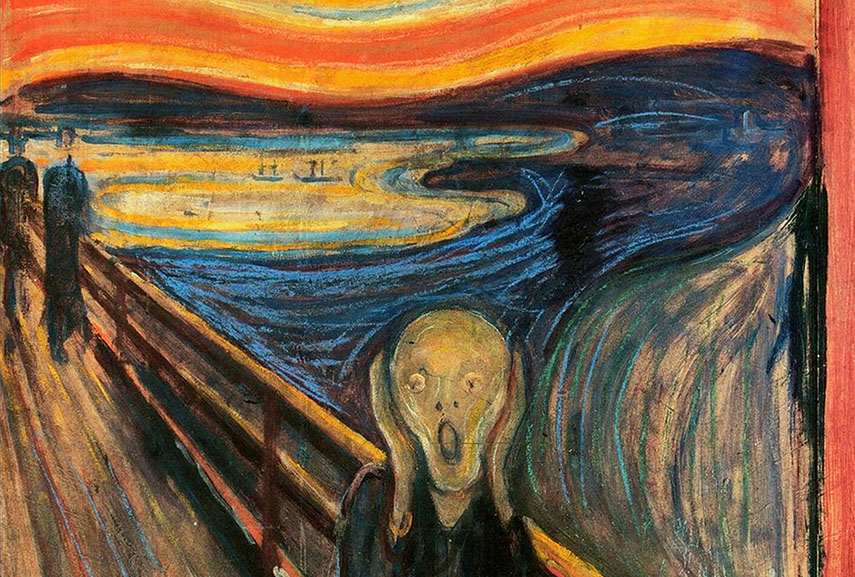
Worldwide
The ideas and approaches of Post Impressionism continued to spread throughout the continent. In Belgium, a group of progressive Brussels-based sculptors, writers and painters came to prominence nether the name Les Vingt (The Xx), promoting the latest international developments in decorative design. Founder members included James Ensor, Theo van Rysselberghe, Alfred Finch and Fernand Khnopff. Italy, on the other hand, saw the birth of Divisionism, inspired by George Seurat's Pointillism and the Belgian art journals information technology was featured in. Artists like Vittore Grubicy De Dragon, who was the founder, forth with Angelo Morbidelli, Giovanni Segantini and Giovanni Sottocornola, mostly depicted landscapes and scenery of rural life. In 1911, Walter Sickert created the famous Camden Boondocks Group in London, which specialized in painting realist scenes using a wide range of Post-Impressionist styles. It was preceded by the more than famous Glasgow School of Painting and the Scottish Colourists, who came to exist strongly influenced by Matisse and the Fauves, for instance. Coming in afterward, in the 1920s, was the Canadian Group of Seven, which included Tom Thomson, Franklin Carmichael, Lionel Fitzgerald and Arthur Lismer, all of whom created lush landscapes that oftentimes hid symbolic meanings.
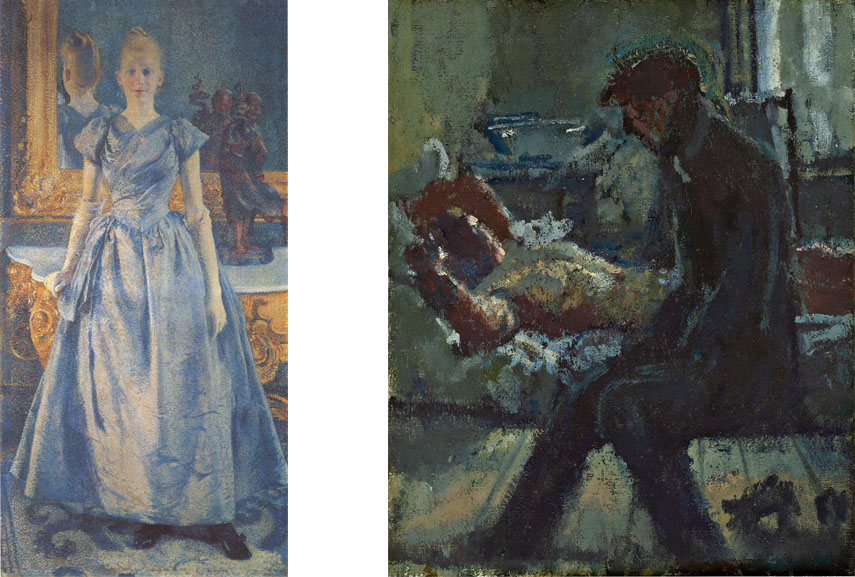
An Influence on Fauvism and Cubism
Fauvism and Cubism, as two major artistic movements which superseded Post Impressionism, were very influenced past its arroyo in virtually every fashion. The Fauves, every bit the artists called themselves, either knew personally or even intimately the work of Post-Impressionists, incorporating the constructive color planes of Cezanne, for instance, Gauguin's Cloisonnism or the pure, bright colors of van Gogh. Furthermore, Matisse credited both Georges Seurat and Paul Signac every bit those who helped him discover his inner "wild beast". In fact, Matisse worked feverishly to capture the color possibilities, through numerous studies and, most notably, his 1905 work Luxe, Calme et Volupté. Mail-Impressionism had a neat impact on Cubism besides, particularly the work of George Braque and Pablo Picasso, who famously referred to Cezanne as "the father of us all". Cubism was concerned primarily with depicting the structure of objects, mostly through thick blocks of color and stiff lining.
Post-Impressionism and Fauvism & Expressionism
Mail service-Impressionism Art - Why Do We Love It?
Is information technology because it was the starting time true rebel of Modern art? Or considering information technology influenced many Modernist movements, such every bit Fauvism, Expressionism, Cubism, Surrealism and even Abstract art to an extent? Maybe considering it gave united states of america masters like van Gogh, Toulouse-Lautrec, Munch and Cézanne. Or perhaps because of that unique feeling we get while we observe these stunning works of art? Post Impressionism art is all of the in a higher place and more. Its painters ventured into uncharted domains, each from their own designated, original path, so they could assign their work with emotions and symbolic meaning. It marked the turn of the last century by making turns in art, and its importance and influence are jump to terminal well beyond that point.

Editors' Tip: Masterpieces of Impressionism and Post-Impressionism: The Annenberg Drove
A revised and expanded edition of the 1989 publication Masterpieces of Impressionism and Post-Impressionism: The Annenberg Drove, this handsome volume presents more than than 50 masterworks by such luminaries as Manet, Degas, Morisot, Renoir, Monet, Cézanne, Gauguin, Van Gogh, Picasso, and Matisse, accompanied past elucidating texts and a wealth of comparative illustrations. The Walter and Leonore Annenberg Drove of Impressionist and Post-Impressionist paintings, watercolors, and drawings constitute ane of the most remarkable groupings of avant-garde works of art from the mid-19th to the early 20th century e'er given to The Metropolitan Museum of Art.
Featured epitome: Vincent van Gogh - The Starry Night, 1889, detail; Paul Cézanne - The Large Bathers, 1906, particular; Henri Rousseau - The Dream, 1910. Images via wikimedia. Used for illustrative purposes only.
Source: https://www.widewalls.ch/magazine/post-impressionism-art
Post a Comment for "Was Post Impressionism Well Accepted by the Art World"